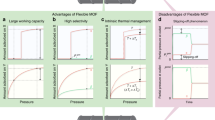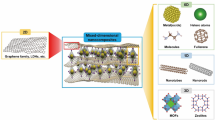Abstract
Adsorbed natural gas (ANG) technology is a viable alternative to conventional liquefied or compressed natural-gas storage. Many different porous materials have been considered for adsorptive, reversible methane storage, but fall short of the US Department of Energy targets (0.5 g g−1, 263 l l−1). Here, we prepare a flexible porous polymer, made from benzene and 1,2-dichloroethane in kilogram batches, that has a high methane working capacity of 0.625 g g−1 and 294 l l−1 when cycled between 5 and 100 bar pressure. We suggest that the flexibility provides rapid desorption and thermal management, while the hydrophobicity and the nature of the covalently bonded framework allow the material to tolerate harsh conditions. The polymer also shows an adsorbate memory effect, where a less adsorptive gas (N2) follows the isotherm profile of a high-capacity adsorbate (CO2), which is attributed to the thermal expansion caused by the adsorption enthalpy. The high methane capacity and memory effect make flexible porous polymers promising candidates for ANG technology.
This is a preview of subscription content, access via your institution
Access options
Access Nature and 54 other Nature Portfolio journals
Get Nature+, our best-value online-access subscription
$29.99 / 30 days
cancel any time
Subscribe to this journal
Receive 12 digital issues and online access to articles
$119.00 per year
only $9.92 per issue
Buy this article
- Purchase on Springer Link
- Instant access to full article PDF
Prices may be subject to local taxes which are calculated during checkout



Similar content being viewed by others
Data availability
The data that support the plots within this paper and other findings of this study are available from the corresponding author on reasonable request.
References
Kumar, K. V., Preuss, K., Titirici, M.-M. & Rodríguez-Reinoso, F. Nanoporous materials for the onboard storage of natural gas. Chem. Rev. 117, 1796–1825 (2017).
Mason, J. A. et al. Methane storage in flexible metal–organic frameworks with intrinsic thermal management. Nature 527, 357–361 (2015).
Peng, Y. et al. Methane storage in metal–organic frameworks: current records, surprise findings, and challenges. J. Am. Chem. Soc. 135, 11887–11894 (2013).
Li, B., Wen, H.-M., Zhou, W., Xu, J. Q. & Chen, B. Porous metal-organic frameworks: promising materials for methane storage. Chem 1, 557–580 (2016).
Deria, P. et al. Beyond post-synthesis modification: evolution of metal-organic frameworks via building block replacement. Chem. Soc. Rev. 43, 5896–5912 (2014).
Guillerm, V. et al. A supermolecular building approach for the design and construction of metal-organic frameworks. Chem. Soc. Rev. 43, 6141–6172 (2014).
Li, M., Li, D., O’Keeffe, M. & Yaghi, O. M. Topological analysis of metal–organic frameworks with polytopic linkers and/or multiple building units and the minimal transitivity principle. Chem. Rev. 114, 1343–1370 (2014).
Krause, S. et al. A pressure-amplifying framework material with negative gas adsorption transitions. Nature 532, 348–352 (2016).
Jung, J. Y. et al. Limitations and high pressure behavior of MOF-5 for CO2 capture. Phys. Chem. Chem. Phys. 15, 14319–14327 (2013).
Byun, J., Patel, H. A., Thirion, D. & Yavuz, C. T. Charge-specific size-dependent separation of water-soluble organic molecules by fluorinated nanoporous networks. Nat. Commun. 7, 13377 (2016).
Patel, H. A. et al. High capacity carbon dioxide adsorption by inexpensive covalent organic polymers. J. Mater. Chem. 22, 8431–8437 (2012).
Tian, T. et al. A sol–gel monolithic metal–organic framework with enhanced methane uptake. Nat. Mater. 17, 174–179 (2018).
Chang, G. et al. A microporous metal-organic framework with polarized trifluoromethyl groups for high methane storage. Chem. Commun. 51, 14789–14792 (2015).
Li, B. et al. A porous metal–organic framework with dynamic pyrimidine groups exhibiting record high methane storage working capacity. J. Am. Chem. Soc. 136, 6207–6210 (2014).
Ma, S. et al. Metal-organic framework from an anthracene derivative containing nanoscopic cages exhibiting high methane uptake. J. Am. Chem. Soc. 130, 1012–1016 (2008).
Eddaoudi, M. et al. Systematic design of pore size and functionality in isoreticular MOFs and their application in methane storage. Science 295, 469–472 (2002).
Olah, G. A., Reddy, V. P. & Prakash, G. K. S. in Kirk-Othmer Encyclopedia of Chemical Technology 159–199 (Wiley, 2000).
Martin, C. F. et al. Hypercrosslinked organic polymer networks as potential adsorbents for pre-combustion CO2 capture. J. Mater. Chem. 21, 5475–5483 (2011).
Tan, L. et al. Hypercrosslinked porous polymer materials: design, synthesis, and applications. Chem. Soc. Rev. 46, 3322–3356 (2017).
Li, B. et al. A new strategy to microporous polymers: knitting rigid aromatic building blocks by external cross-linker. Macromolecules 44, 2410–2414 (2011).
Wang, S. et al. Layered microporous polymers by solvent knitting method. Sci. Adv. 3, e1602610 (2017).
Li, L., Cai, K., Wang, P., Ren, H. & Zhu, G. Construction of sole benzene ring porous aromatic frameworks and their high adsorption properties. ACS Appl. Mater. Interfaces 7, 201–208 (2015).
Msayib, K. J. & McKeown, N. B. Inexpensive polyphenylene network polymers with enhanced microporosity. J. Mater. Chem. A 4, 10110–10113 (2016).
Jiang, J. et al. High methane storage working capacity in metal–organic frameworks with acrylate links. J. Am. Chem. Soc. 138, 10244–10251 (2016).
Ullah, R. et al. Investigation of ester- and amide-linker-based porous organic polymers for carbon dioxide capture and separation at wide temperatures and pressures. ACS Appl. Mater. Interfaces 8, 20772–20785 (2016).
Mason, J. A., Veenstra, M. & Long, J. R. Evaluating metal-organic frameworks for natural gas storage. Chem. Sci. 5, 32–51 (2014).
Yuan, D., Lu, W., Zhao, D. & Zhou, H.-C. Highly stable porous polymer networks with exceptionally high gas-uptake capacities. Adv. Mater. 23, 3723–3725 (2011).
Casco, M. E. et al. High-pressure methane storage in porous materials: are carbon materials in the pole position? Chem. Mater. 27, 959–964 (2015).
Patel, H. A., Byun, J. & Yavuz, C. T. Carbon dioxide capture adsorbents: chemistry and methods. ChemSusChem 10, 1303–1317 (2017).
Wu, K. et al. Methane storage in nanoporous material at supercritical temperature over a wide range of pressures. Sci. Rep. 6, 33461 (2016).
Alezi, D. et al. MOF crystal chemistry paving the way to gas storage needs: aluminum-based soc-MOF for CH4, O2, and CO2 storage. J. Am. Chem. Soc. 137, 13308–13318 (2015).
Kong, G. Q. et al. Expanded organic building units for the construction of highly porous metal–organic frameworks. Chem. Eur. J. 19, 14886–14894 (2013).
He, Y., Zhou, W., Yildirim, T. & Chen, B. A series of metal–organic frameworks with high methane uptake and an empirical equation for predicting methane storage capacity. Energy Environ. Sci. 6, 2735–2744 (2013).
DeSantis, D. et al. Techno-economic analysis of metal–organic frameworks for hydrogen and natural gas storage. Energy Fuels 31, 2024–2032 (2017).
Acknowledgements
This work was supported by National Research Foundation of Korea (NRF) grants funded by the Korean government (Ministry of Science, ICT and Future Planning) (nos NRF-2016R1A2B4011027, NRF-2017M3A7B4042140 and NRF-2017M3A7B4042235).
Author information
Authors and Affiliations
Contributions
V.R. synthesized and characterized all the sorbents. D.T. helped in syntheses and analyses. R.U. and M.A. carried out high-pressure pure-gas uptake studies. V.R. and J.L. tested COP-150 in an actual cylinder. M.J. and H.O. collected cryogenic (111K) CH4 isotherms. M.A. explained the high-pressure behaviour of the sorbents. C.T.Y. conceived the project and wrote the manuscript with contributions from all authors.
Corresponding authors
Ethics declarations
Competing interests
KAIST has filed a provisional patent application (10-2019-0058296) related to the new flexible porous polymers reported in this manuscript.
Additional information
Publisher’s note: Springer Nature remains neutral with regard to jurisdictional claims in published maps and institutional affiliations.
Supplementary information
Supplementary Information
Supplementary Methods, Supplementary Notes 1–3, Supplementary Figs. 1–35, Supplementary Tables 1–10 and Supplementary refs.
Rights and permissions
About this article
Cite this article
Rozyyev, V., Thirion, D., Ullah, R. et al. High-capacity methane storage in flexible alkane-linked porous aromatic network polymers. Nat Energy 4, 604–611 (2019). https://doi.org/10.1038/s41560-019-0427-x
Received:
Accepted:
Published:
Issue Date:
DOI: https://doi.org/10.1038/s41560-019-0427-x
This article is cited by
-
Efficient crystal structure materials as reactive sorbent for the CO2 and CH4 adsorption and storage
Scientific Reports (2024)
-
Nanoporous carbons based on coordinate organic polymers as an efficient and eco-friendly nano-sorbent for adsorption of phenol from wastewater
Scientific Reports (2023)
-
Current overview of the valorization of bio-wastes for adsorbed natural gas applications
Carbon Letters (2023)
-
Fluorescence determination of tannic acid imprinted in conjugated hypercrosslinked polymers by Friedel–Crafts acylation
Microchimica Acta (2023)
-
Fluorescent porous organic polymers for detection and adsorption of nitroaromatic compounds
Scientific Reports (2022)



